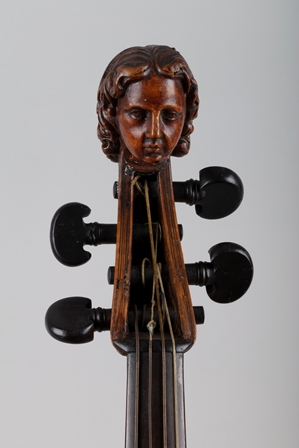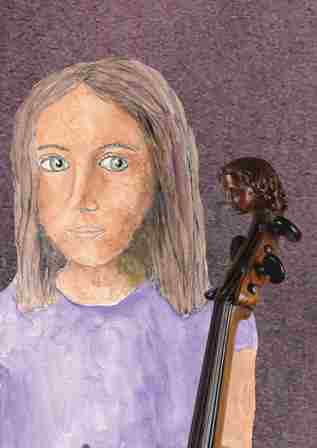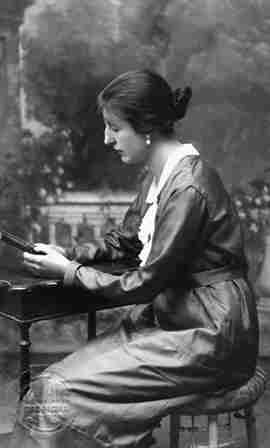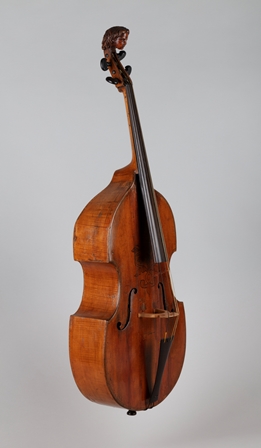
News
The Passage of Time
The first glimmers of dawn greet me, and the transparent windows reflect static shapes. The light gives way to movement, and life awakens. The doors have opened, and the first visitors stroll along the musical paths of the past. We are in a hall of the Barcelona Museum of Music, where the silence of the instruments explains the art of sounds.
Before me, I have three gazes. Three people, three generations of the 21st century who wants to know the sounds of history. The bright eyes of a girl, the serenity of a woman, and, in the shadows, the face of old age. They look at me attentively; it's as if my body were a powerful magnet for their gaze. What do I have to attract three such different people in this way? I would like to, but I cannot, know what thoughts are passing behind those eyes. Yes, I will talk to them; I will tell them about me, my past, my present. In fact, I cannot do anything else. Now, no one listens to my voice anymore, but you are here, and perhaps you will hear what a tired body like mine can tell you.
Forgive me; I hadn't told you who I am. It doesn't matter much, but it's worth starting here. In fact, I am a viola da gamba, yes, that ancient instrument that is also called a viola da gamba and might remind you of a cello. It was called da gamba in Italian because it was played held between the legs (le gambe).

1. The Passage of Time
If I start to remember, I get emotional. I almost remember things from before I was born. I smell nature, the forest, the mountains, and the river. The cold, the sun, the wind, the mist, the rain, and the snow are still inside me; I am sure of it. It is nature that drew my body with unique, exclusive veins. They are like the fingerprints of your hands, like the features of your faces.
I remember little else from those times. Yes, the pain, the wound, the separation, and then the loneliness and the darkness. I was no longer a tree; I was wood. But eyes and hands gave me back my life.
I was born near Saint Paul's Cathedral in London. It was the gaze of Barak Norman that transformed my body. My veins enchanted him, and then his delicate and strong hands sought the shape. I soon forgot the pain of the tool's cut. It was an autumn day in 1713 when, in the hands of that luthier, Barak Norman, my father, I knew that I was beginning to live. I was born to sing, to make my voice heard.
The artisan master had sought in me the balance. Yes, the strength of my structure had to resist the tension of the strings and at the same time have the delicacy to vibrate with them. Together we had to perform the dance of the waves, the dance that transforms the imperceptible movements of the instrument into sounds that spread through the air, seeking those who want to listen to them.
Early in the morning, the luthier would take me. He would look at my young face, sculpted by himself, and then tighten the strings, a little more every day. When the bow passed, a trembling, timid, and imprecise voice emerged from me. And little by little, those hands taught me to sing.

2. Scroll Sculpture
Now more than 300 years have passed. I see the child's face in front of me; soon it will transform. I see life in their eyes, curiosity, the desire to know. Also, restlessness, indecision. Day after day, their world grows, fills. Their nervous hands seem to want to grasp who knows what, but their gaze never strays from me for a single moment. Perhaps you'd like to know how I began to walk through life.

3. The Gaze, the Silence, the Word
At the beginning of the 18th century, I grew up in the hands of a very young girl, Hannah. Together, we first discovered the sounds, seeking beauty, expression, strength, and tenderness. Then, the sounds turned into music, and emotion filled our lives. We spent hours, days, and years searching and finding life in that small room. Laughter and tears turned into sounds, and joy and pain turned into music. Then, our voice went out into the world.
It was in a small palace. Intimacy disappeared, and I felt the attention of all eyes on me. It was the beginning of a long life. First, all alone, always in the hands of Hannah. Soon, I played with other instruments. We formed small groups of two, three, or more viols. Each one was a different size, and our voices flew through the wide sound space. From the lowest sounds that seemed to rise from the depths of the earth to the highest ones that soared higher than the daring birds.
I also made music with very different instruments from me. I remember when the harpsichord, or often a lute, drew a path of playful notes, and I, slowly or perhaps joyfully, walked through it like a deer running through a forest. Sometimes it was me accompanying the harpsichord with my low notes. Together, we made the path, and another instrument, with a higher and clearer voice, like a violin or a flute, walked through the landscape that we drew.
I have sung in many places and countries. For many years, in the hands of Hannah, who grew up with me. Then, with the passage of time, other hands took care of me. Perhaps not all with the same affection. I have often gone from being wrapped in the softest silks to being completely abandoned. More than one musician has left me in the cold or the rain while their hands raised a glass of wine. The music that has emerged from within me has been heard by kings and princes, but it has also been danced to by the highest nobility and the simplest people of the villages. And all of this is part of life and is reflected in my body. Bumps and cracks are drawing a story, like the small wrinkles that, with the years, show the wisdom and experience in the faces of people. And little by little, I don't know if my voice lost its brightness or maybe my way of singing seemed too old-fashioned; I saw how they were leaving me in a corner.
Now, from the display case, I see the smile of this girl, who will soon be a young woman, in front of me. The world calls her, and she wants to fill her life with life. She leaves, light, surely her hands will someday play with sounds, and music will fill her life.
Let's go back to the 18th century. I must say that my existence is very long. Much longer than a person can live. Several generations of musicians have played with me. And I can continue to sing with each voice more precise, richer. But it is humans who change, and I don't know if I can change much.
For a long time, the viol family and the violin family shared many scores. Our voices were different, but we could all play the same music. Often, we even played together. But music, made by men and women, changes, just like society and the places they live. Just in the middle of the 18th century, it seemed that the intimacy and sensitivity of our sound, the voice of the viols, was not the most suitable for the music that was beginning to be made. The sound had to be brighter, more powerful, more incisive. And the violins and cellos had the upper hand. And they won. And I, the bass viola da gamba, born from the hands of Barak Norman, knew segregation, marginalization, and oblivion.
It has been a long time, and now I notice this woman in front of me; only glass separates us. Observing her gaze and her hands, I can imagine a whole world, yes. I see music in her fingers, but at some point in her life, other things occupied those hands and those eyes. The art of sound fell silent, and other desires or needs filled her path. Maybe now there will be a change in her life. She wants to know; she listens to me with her gaze.
I speak to her.
The fear of silence, the terror of change, transformation, and loss shook me. Could an instrument with such a delicate voice as mine be transformed to play what the musicians demanded?
And the hands of a luthier worked on my body. I lost two of the six strings I had. The two openings in the shape of a C, the mouth from which my voice came out, were soon closed. In their place, two openings in the shape of an f were created. I would no longer sing as a bass viola da gamba; now, I was a cello.



4. Scroll and fingerboard 5. Soundboard detail 6. Viola acoustic opening
The change was accompanied by pain, uncertainty, and fear. I didn't know who I was; I didn't recognize myself.
And my voice? Was it me?
And then came learning. A young person's hands spent long hours working with me. At first, I experienced it as exercises, but my voice and those hands discovered new music in that cello suite. The compositions of Johann Sebastian Bach, which had transported me beyond the beauty of sounds so many times, now showed me the song of the cello, my sound, my music.
And in this new time, this world that I thought was not mine, showed me a new way to discover the emotion of singing. When the musician's hands played with me, my voice could be as gentle as a whispered word. But also, my singing could transform into a powerful, loud, potent cry. I no longer spent so much time in solitude. Every day, I shared my sound with other instruments, and our songs reached farther. Small groups of instruments became larger orchestras. It was not just me telling a story; we were a group of cellos adding our voices to fill the space with sounds, harmoniously blended with the other instruments.

7. The Gaze and Desire
I stop talking about myself. I return to the gazes in front of me. I see strength and desire in this woman. She leaves slowly, gives me one last look, and her smile tells me she is going to live a new life. Music will surely accompany her.
And in front of me, there is only the man with full eyes. Full of wisdom, of life. His hands have lost the strength and energy of youth, but they surely retain tenderness and memory. I see imperceptible movements in those fingers. They are traveling through the space of sounds while his gaze listens to me.
I cannot remember how many concerts I have given. I cannot know how many stages I have shared. I do remember all the music that has come from within me. I could sing them all. Often, I feel the lack of one or many voices of other instruments. I need them to relive those musics where the emotion was about sharing, adding, and growing to express what only music can explain.
And with the passage of time, a new solitude invaded me. Not always can the hands that accompany you save you from everything. And little by little, the harshness of the paths leaves the deepest mark. And my travels and concerts became rarer until they were forgotten. And the reason for my existence, sound, was locked inside me. And darkness and silence came.
One day, now talking about the early 20th century, a certain light woke me from my sleep. I found myself surrounded by other unknown objects. They were not musical instruments; we were just witnesses of the past sharing a space. An antique dealer hoped that some sensitive person might be interested in some object.
One afternoon, a voice entered through the door and found in my silence the word. I had stopped living for what I was born for, music. My body, battered by time, lay inert. Only two poorly secured strings remained over me, holding up the bridge on a body full of cracks. The hands of a woman, Orsina Baget, touched me. She was not looking for the sounds of music in me. Her gaze touched beauty, and her eyes listened to the silent voice of the past. It was at that moment that I felt that, despite my silence, I could speak. My woods told of the cold and the sun of that forest that, with the patience of years, painted all my skin. And the beauty of my curves and the color of my varnish were like that document that explains in detail how the master Barak Norman worked to transform matter into an instrument. Each of my wounds told a story, and the wear and tear of my forms were like a score where each note that had emerged from me was written down. The imprints of all those hands that had played with me were a delicate suite of all the melodies of my history.


8. Orsina Baget; 9. Orsina Baget with a zither from her collection
I spent a few years sharing space and gazes with Orsina and a considerable group of instruments. Among all of us, we could tell many stories; she knew how to listen to the absence of sound and love beauty. Later, she wanted to share this treasure, and here I am, in the Museum of Music, telling you about my life.
The face that listens to me says goodbye. I know that her fingers have played with music; now she also knows how to listen to my silence.
In the next room, some notes are playing. It's a bass viola da gamba.

10. Bass viola da gamba, by Barak Norman, MDMB 412
Description of images:
- The Passage of Time. Illustration: Oriol Rossinyol. Photograph: Jordi Puig
- Scroll Sculpture. Foto: Jordi Puig
- The Gaze, the Silence and the Word. Illustration: Oriol Rossinyol. Photograph instrument: Jordi Puig
- Scroll and Fingerboard. Left figure: virtual restoration of the original viola da gamba scroll. Fingerboard and fingerboard with six strings. Right figure: Current state transformed into cello. Four pegs on the fingerboard and a fingerboard with four strings. Assembly: Oriol Rossinyol. Photograph: Jordi Puig
- Detail of the soundboard of the instrument with an acoustic opening in the shape of an f. A silhouette in black can be seen, corresponding to the old acoustic opening in the shape of a C. Assembly: Oriol Rossinyol. Photograph: Jordi Puig
- Detail with the usual inverted C of violas da gamba and currently covered, marked in gray. Photograph: Jordi Puig.
- The Gaze and Desire. Illustration: Oriol Rossinyol
- Orsina Baget Tarrés, wife of the art historian Joaquim Folch i Torres. His collection of musical instruments entered the Music Museum in 1947. Photograph: Fundació Folch i Torres. FFT 1352
- Orsina Baget Tarrés, with a zither . Badalona, 1914. Photograph: Fundació Folch i Torres. FFT 1350
- Bass viola da gamba - cello. MDMB 412. Built by Barak Norman in London in 1713. At some point it has been transformed into a cello but the head and part of the peg are original. The harmonic table, pumped and in the shape of eight, originally had two acoustic openings in the shape of ces that were covered and opened again in the shape of ephes. It has a curved peg and the head is carved in the form of a teenage head with long hair. Photograph: Jordi Puig

